Fractal Design Node 605 Case Review: Is Fractal Design Ready for Primetime?
by Dustin Sklavos on January 1, 2013 12:01 AM EST- Posted in
- Cases/Cooling/PSUs
- HTPC
- Fractal Design
Noise and Thermal Testing, Dedicated GPUs
The Fractal Design Node 605 is capable of offering at least a passable performance with our bone stock mITX testbed, but it's really not leaving the end user much headroom to upgrade. Now we're going to add dedicated graphics cards to the mix: the sub-75W Zotac GeForce GTS 450 Eco, and the more robust ASUS GeForce GTX 560 Ti. Unfortunately, you'll see the Node 605's fortunes don't really improve.
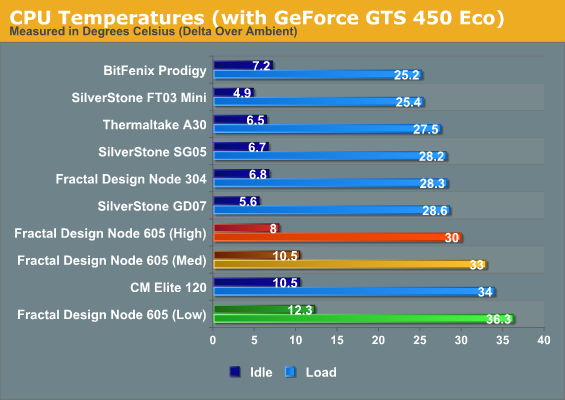
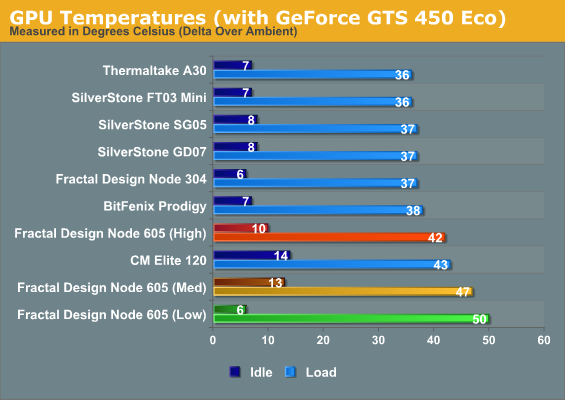
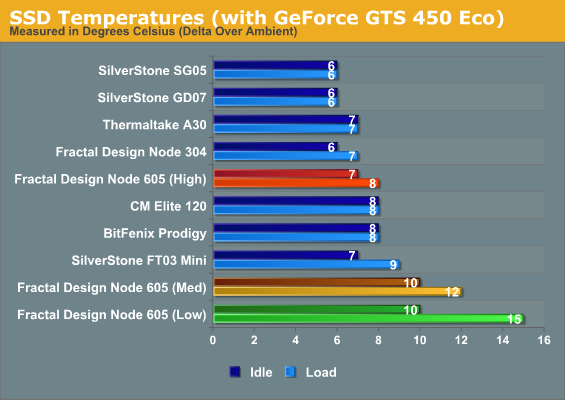
Add in a video card and thermals go straight to hell. Even the high fan setting can't seem to salvage it, and our SSD is producing some of the hottest temperatures we've yet recorded. You can see the GTS 450 Eco typically runs pretty cool, but in the Node 605 it's hotter than we've ever seen it, and heat seems to be getting trapped between the card and the CPU.
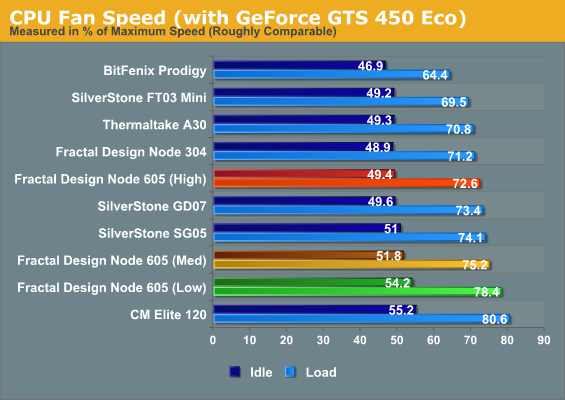
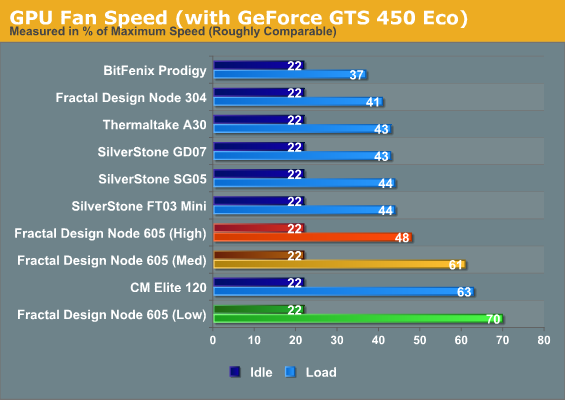
Fan speeds are up there, too. Nothing in the Node 605 is actually overheating, but it's clear this case's cooling design needs to go back to the drawing board.
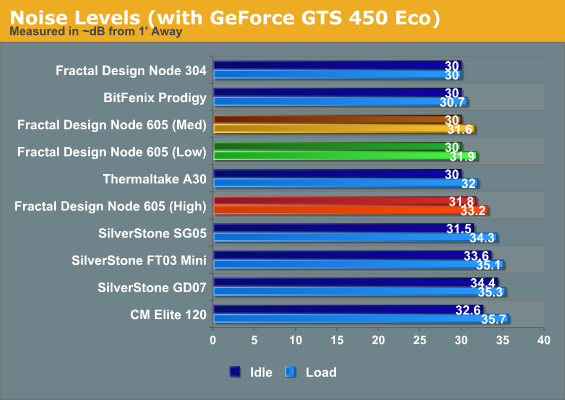
The Node 605 is able to at least run quieter than a lot of the competition, but embarassingly the substantially smaller Node 304 continues to offer superior performance across the board.
The Fractal Design Node 605 was already having issues with a modest card like the Zotac GTS 450 Eco, so you can probably guess how things went with the GTX 560 Ti installed.
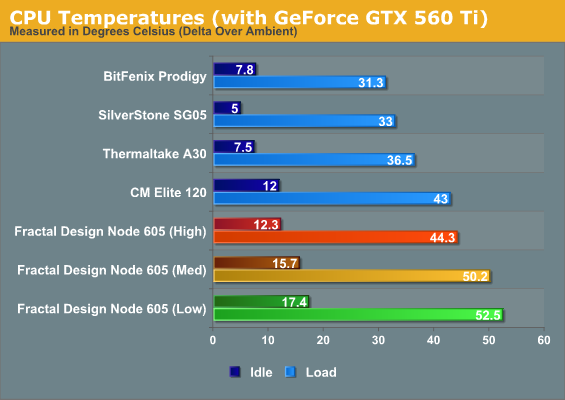
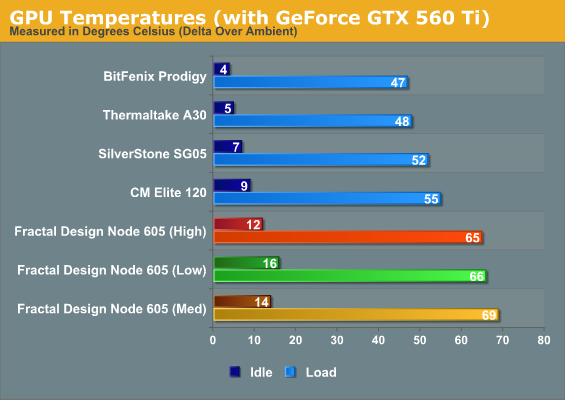
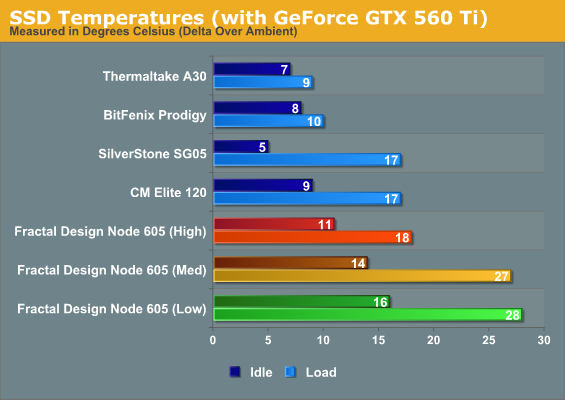
Thermals shoot through the roof. Even with the fan set to high, the Node 605 is beaten in every test. Again, nothing is overheating (except possibly the SSD, which reported a high temperature of a blistering 51C), but it's clear the Node 605 isn't very efficient at moving heat.
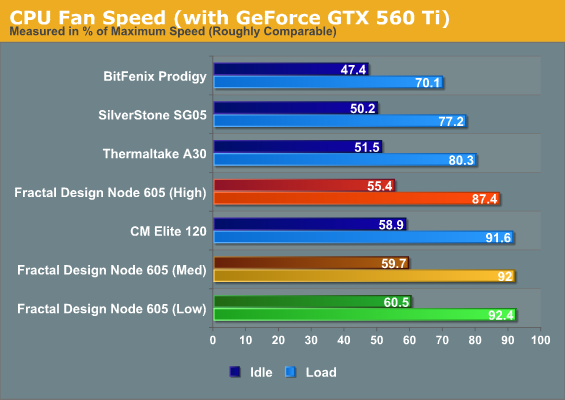
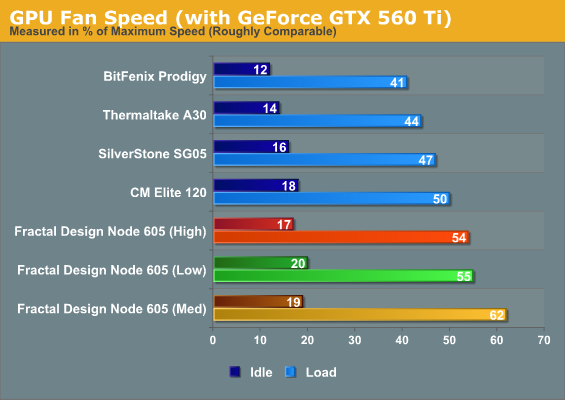
Fan speed measurements just reiterate what we already know: the Node 605 has very limited thermal headroom, and it's having trouble competing with cases half its size.
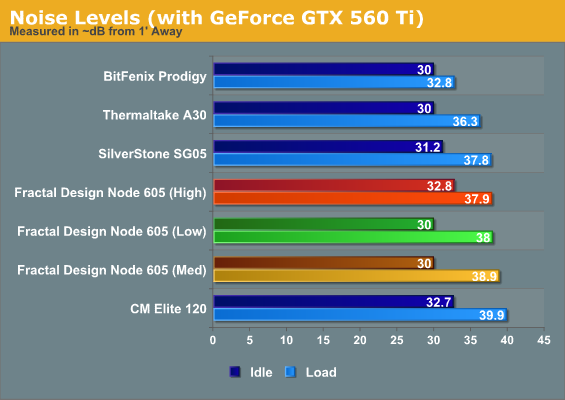
With this much of a thermal load placed on it, the Node 605 just can't stay quiet.
During testing I actually ran the system with the top panel open to make sure the fans were spinning, and they were, even on the lowest setting. The problem was that you could barely feel any air coming off of them, and this translated to a poor showing in testing.










52 Comments
View All Comments
Blibbax - Tuesday, January 1, 2013 - link
If you for some reason insist on using only two fans, have one at the side (next to the PSU, I suppose) as an intake, and one next to the CPU above the backplate as an exhaust.Fractal have done what they have with the fans because they (rightly) assume that users will want to drop in at least one of their own choice of exhaust fan. Ignoring this in an otherwise excellent and well thought out review is a huge shame imo.
chrissp - Tuesday, January 1, 2013 - link
I havent seen any reviews for the Origin AE lineup on your site? I have the s14v in black and it is the nicest htpc case on the market imo. it is expensive but its made from a solid block of aluminium so i think its worth it.would love to see some reviews for their ranges on here.
thanks for the great great reviews.
chris
Conficio - Tuesday, January 1, 2013 - link
Really, what do you do with ports behind a flap? I might understand it for a card reader and may be a DVD drive? But head phones and mic and USB ports behind a flap? What is the user experience of this? If I use such things, the flap needs to stay open, so making the entire design horrid. I'd understand if the USB ports would be sideways and the flap had side channels to route the cables of an external drive, so I can still close it. But mic and head phone ports need to be outside of the flap!For that price, I'd like to see some display included, that can be controlled by software. I'd think that it must be possible to produce a simple display with a USB interface that can show output channel, and volume, etc. just by the virtue of it's driver. Not to mention adding any sort tuner card and being able to see tune information or similar.
kenyee - Tuesday, January 1, 2013 - link
with a 2500K, it's not even audible and there's enough space.Would have been nice if this case worked well though...having space for 4 drives would have been nice...
smitty123 - Tuesday, January 1, 2013 - link
i don't need flash , just something else than a gray slab.rockoqatsi - Wednesday, January 2, 2013 - link
I don't need flash either. And I'll deviate from most posters and say that this is one of the best HTPC chassis I've ever seen for the money (if only just from the front.)I like that the optical bay and all of the I/O ports are behind a flap. I don't need (visible) ports, a headphone or mic jack, and all sorts of buttons---and certainly not a volume knob---on my HTPC. I have a bloody preamp for that. And as far as VFDs and touchscreens go, they look pretty, but at the end of the day are a distraction. Touchscreens are for remotes anyway. An HTPC should be like Seraph from The Matrix: dark, svelte, mysterious, pretty, and silent.
So on the outside the Node 605 does just fine for me. It's such a shame the interior was designed by an ape. Why did they put the HDD hangers on the same side as the expansion slots, power supply and optical bay? The cpu side is like Montana and the other is like Tokyo. No f---ing sense for a case this size.
perrydoell - Wednesday, January 2, 2013 - link
After all these years, and no case designer cares to design their case with airflow in mind?I mean, all I see is a box with holes all around it. You design your own airflow, depending upon what you put in and where you put the fans. I'm sure a thermal engineer geek (I'm an electrical engineering geek myself :-P ) could design a case that has a single, well defined airflow path that could have far better thermal and accoustic performance than you or I could manage.
cjs150 - Thursday, January 3, 2013 - link
Silverstone TJ08-E springs to mind as clearly designed around proper airflow.Personally I wonder why there is a need for these big HTPC cases. To be honest they are nothing more than a standard 1990s case laid on its side. Having built a silent HTPC, mini-itx motherboard was sufficient for me (but I do have a separate NAS for storage), although I accept some audiophiles will want a separate audio card
Wwhat - Sunday, January 6, 2013 - link
It's amazing how involved people get with something that is just a metal box.And even more amazing and odd what some companies ask for it. Especially since some devices/tools/vehicles come with large metal housings and those don't seem to significantly influence the cost half the time.
But on the other hand some basically simple spare parts for cars that are very basic are also sold for outrageous prices if they are hard to source. It truly is a fine example of price and demand and making a business out of things.
dj christian - Thursday, January 10, 2013 - link
"ATX motherboard support on the right side of the case, power supply standing on its side on the left."should be
ATX motherboard support on the left side of the case, power supply standing on its side on the right.